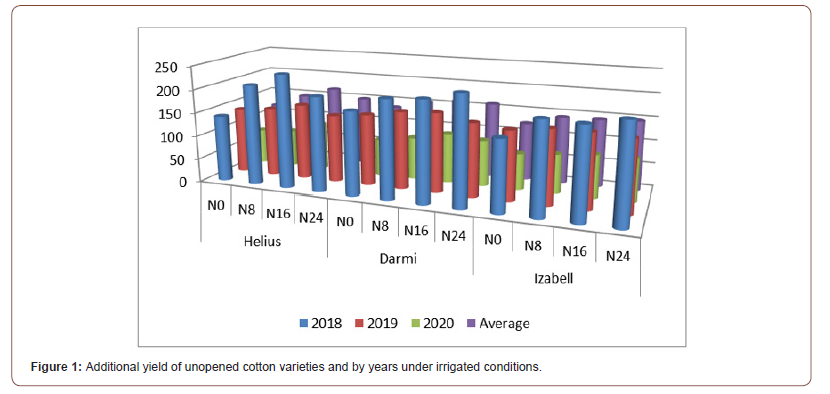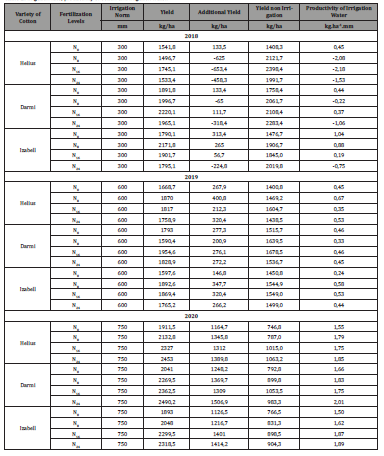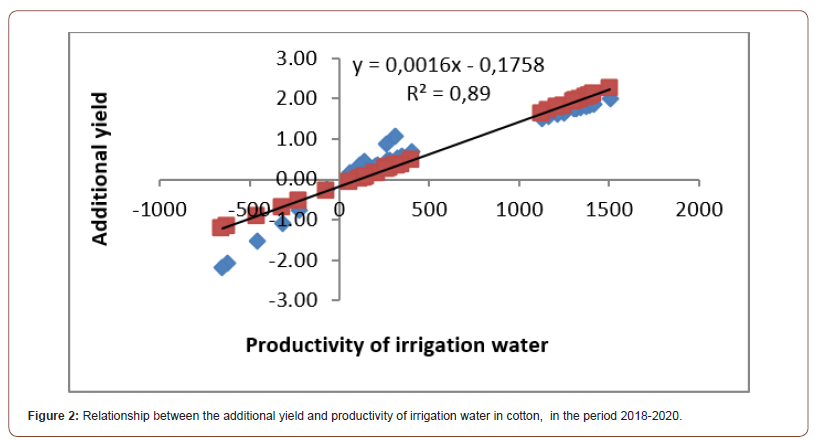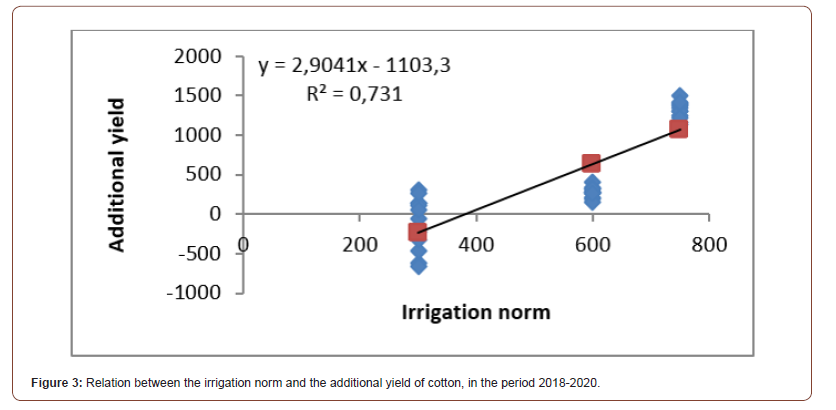 Review Article
Review Article
Evaluation of Watering Water Productivity in Three Cotton Varieties!
Antoniya Stoyanova*
Faculty of Agriculture, Trakia University, Stara Zagora, Bulgaria
Antoniya Stoyanova, Faculty of Agriculture, Trakia University, Stara Zagora, Bulgaria.
Received Date: May 25, 2021; Published Date: June 18, 2021
Abstract
Drought can have different strengths and further effects after a number of crops, one of which is cotton. The formation of a highly efficient visit of cotton by adding technology for viewing to specific soil and climatic conditions, including control of nitrogen fertilization and feeding, is the main way to obtain stable profits.
The productivity of cotton varies greatly depending on the moisture conditions during the growing season. Under optimal temperature conditions, humidity dominates over other factors. The correlation coefficient between yields and moisture supply for the period May-August is r = 0.76 [1]. In years with lower temperature supply, the best results were obtained at an irrigation rate of 74.0 mm. Under these conditions, an increase in the yield of unpinned cotton by 41% was found, Saldjiev & Nikolov [2] found.
By reducing the irrigation rate to 60 mm, irrigation costs are reduced to 62%, the net income of 100 m3 of irrigation water is higher, and the effect of 1 m3 of water is the greatest. With deficient irrigation, crops are intentionally exposed to water stress, leading to reduced yields [3,4].
Trends in the impact of drought on crops are also analyzed using various dependencies and models and serve to predict crop productivity [5,6].
The purpose of this study is to investigate the effect of irrigation and the productivity of irrigation water in three varieties of cotton grown under conditions of natural moisture and irrigation. To study the nature of the dependences between the productivity of cotton and the irrigation rate, the productivity of irrigation water and the additional yield during different years of rainfall.
Material and Methods
The field experiment was conducted in the period 2018- 2020 in the experimental base of the Faculty of Agriculture, Trakia University, Stara Zagora, on a soil type of typical meadowcinnamon soil in a fertilizer experiment under non-irrigated and irrigated conditions. The object of the study are three varieties of cotton - Helius, Darmi and Isabel. The varieties are a product of the Bulgarian selection, developed under different selection programs.
The study was conducted with four levels of nitrogen fertilization. Nitrogen fertilization rates for cotton are 0; 8; 16 and 24 kg / da. Nitrogen such as NH4NO3 for cotton was applied once before sowing. Irrigation was carried out with a drip irrigation system with built-in drippers at 0.15 m, with an irrigation rate of 15 mm when reaching 75% FC (Field Capacity) for the layer 0-50 cm. Soil moisture dynamics was measured periodically with a soil moisture probe.
Results and Discussion
The analysis shows that the cotton is grown in conditions of optimal temperature resources and unstable moisture. Although cotton is a relatively drought-resistant crop, the results show its responsiveness in optimizing the water factor. The uneven distribution of precipitation determines the need for irrigation for soil moisture supply.
The provision with precipitation for the period May-October in the first year is 29.2%, which defines the period as average, but with values close to moderately humid. With 42.3% and 52.2% security, the second and third years are characterized as averages in terms of the vegetation period (Table 1). For the period characterized by higher average daily temperatures in June-August, the provision with precipitation in the first year characterizes the period with values close to moderately humid (27.0%). Regardless of the registered precipitation in the second year of the Polish survey, the period is characterized by an average coverage of precipitation (31.4%). The lower amount of precipitation in the third experimental year defines it as the average in terms of rainfall (50.0%). The uneven distribution of precipitation determines the need for irrigation for soil moisture supply.
Table 1:Provision with precipitation and temperatures during the cotton growing season.

During the three years of the field study, a different number of irrigations were realized to maintain the soil moisture above 75% FC for the layer 0-50 cm. In the first year, two irrigations with an irrigation rate of 300 mm were realized. In the experimental year 2019, four irrigations were submitted, with an irrigation rate of 600 mm, and in the last five irrigations with a size of 750 mm were registered. Additionally, the fed water is fed through the budding and flowering phenophases.
Figure 1 shows the dynamics of the additional yield by years. The analysis shows how at different irrigation rates an additional yield is obtained in a wide range. The years of research are characterized by different volumes of precipitation.

In the present study, an analysis was made of how efficiently the water resource is used to increase cotton yields. The productivity of irrigation water varies widely from -2.18 to 2.01 kg.ha-1.mm. From the attached table (Table 2) it can be seen that the Isabel variety is characterized by the highest productivity of irrigation water 0.84 kg.ha-1.mm, on average for the studied period. It is followed by Darmi variety with 0.71 kg.ha-1.mm and Helius variety with 0.30 kg.ha-1.mm. The analysis of the results shows that at zero fertilization the highest productivity of irrigation water was registered 0.87 kg.ha-1.mm, on average for the three varieties. The different moisture supply over the years shows the efficient use of irrigation water. In the first year, the fallen precipitation contributed to the optimization of the water factor, and the additionally realized irrigations in some variants formed a negative productivity.
Table 2:Irrigation rate, productivity of cotton and irrigation water.

In the third year of the field experiment, the applied irrigations contributed to obtaining an additional yield in all variants. This year the highest results of irrigation water productivity were registered.
Statistical analysis of the data establishes the nature of the dependences between the individual studied factors additional yield and productivity of the irrigation rate.
The analysis of the data shows that there is a strong positive linear relationship between the additional yield and the productivity of the irrigation rate. The correlation coefficient was determined, r = 0.943. Correlation analysis of the data shows that there is a strong positive linear relationship between the additional yield and productivity of the irrigation rate, or the dependence is linear (Figure 2). As a result of the applied analysis of variance, the coefficient of determination was established (Figure 3). In the present study, it has a value (R2 = 0.731), which shows that approximately 77% of the variation in the dependent trait (productivity of the irrigation rate) is explained by regression. The linear regression shows a high degree of correlation between the independent variable irrigation rate and the dependent variable additional yield.



There is a strong positive linear relationship between additional yield and irrigation rate and rainfall (R2 = 0.72) (Figure 4).
Knowledge of the nature of dependencies is a prerequisite for the efficient use of water resources. The tendency to reduce water resources worldwide is a prerequisite for refining irrigation technologies, for developing a strategy for reducing inefficient water consumption.
Therefore, an in-depth study of the relationship between the factors determining the productivity of irrigation water is needed.
Conclusion
The productivity of the irrigation water is calculated, which from -2.18 to 2.01 kg.ha-1.mm, during the years with different precipitation provision.
The existence of a strong positive linear relationship between the additional yield and the productivity of the irrigation rate has been established. The correlation coefficient was determined (r = 0.943).
Acknowledgement
None.
Conflict of Interest
No conflict of interest.
References
- Milkovski J, M Bozhinov, L Dimitrova (1983) Cotton in Bulgaria. Ed. Hr. G Danov, Plovdiv, pp. 123-130.
- Saldjiev I, G Nikolov (2005) Irrigation regime with regulated water deficit of cotton. Plant Sciences 4: 67-73.
- Igbadun HE, BA Salim, Tarimo AKPR, Henry F Mahoo (2008) Effects of deficit irrigation scheduling on yields and soil water balance of irrigated maize. Irrig Sci 27: 11-23.
- Zhang H, A Khan, DKY Tan, H Luo (2017) Rational Water and Nitrogen Management Improves Root Growth, Increases Yield and Maintains Water Use Efficiency of Cotton under Mulch Drip Irrigation. Front Plant Sci 30.
- Dochin K, V Kuneva, A Ivanova, I Iliev (2018) Current state of phytoplankton in Batak reservoir (Southwestern Bulgaria), Bulgarian Journal of Agriculture Science 24(4): 686-697.
- Kostadinov K, S Filipov, D Valcheva, V Kuneva (2019) Influence of biological fertilization on vegetative behavior and productivity of greenhouse eggplant. Scientific Papers, Series B Horticulture 63(1): 297-305.
-
Antoniya Stoyanova. Evaluation of Watering Water Productivity in Three Cotton Varieties. World J Agri & Soil Sci. 7(2): 2021. WJASS.MS.ID.000658.
-
Water productivity, Cotton varieties, Temperature, Rainfall, Nitrogen, Fertilization
-

This work is licensed under a Creative Commons Attribution-NonCommercial 4.0 International License.






